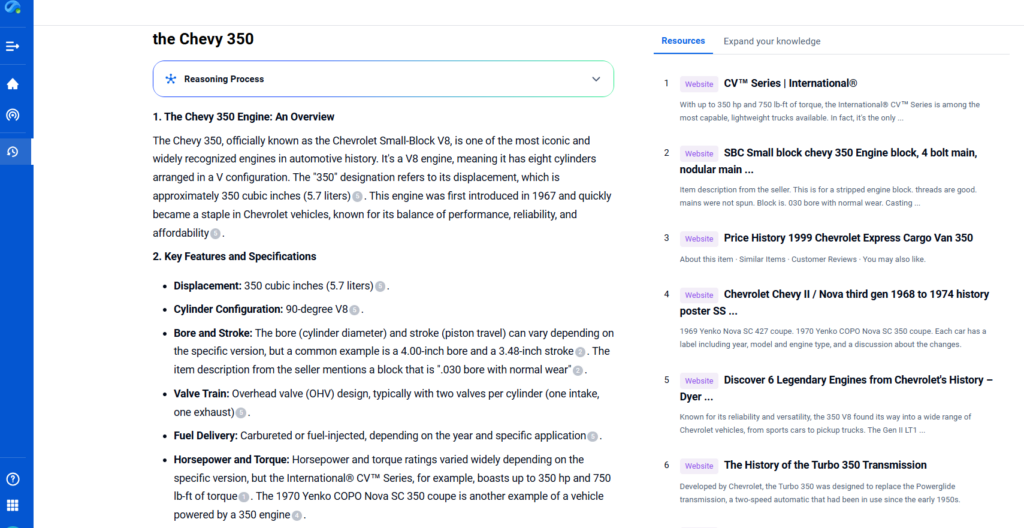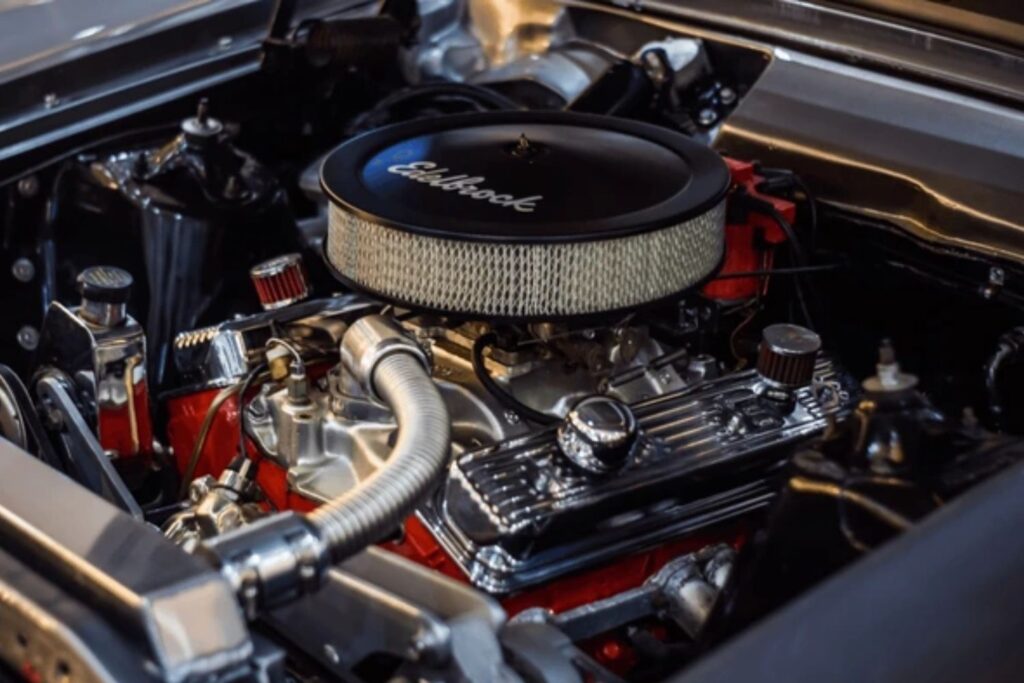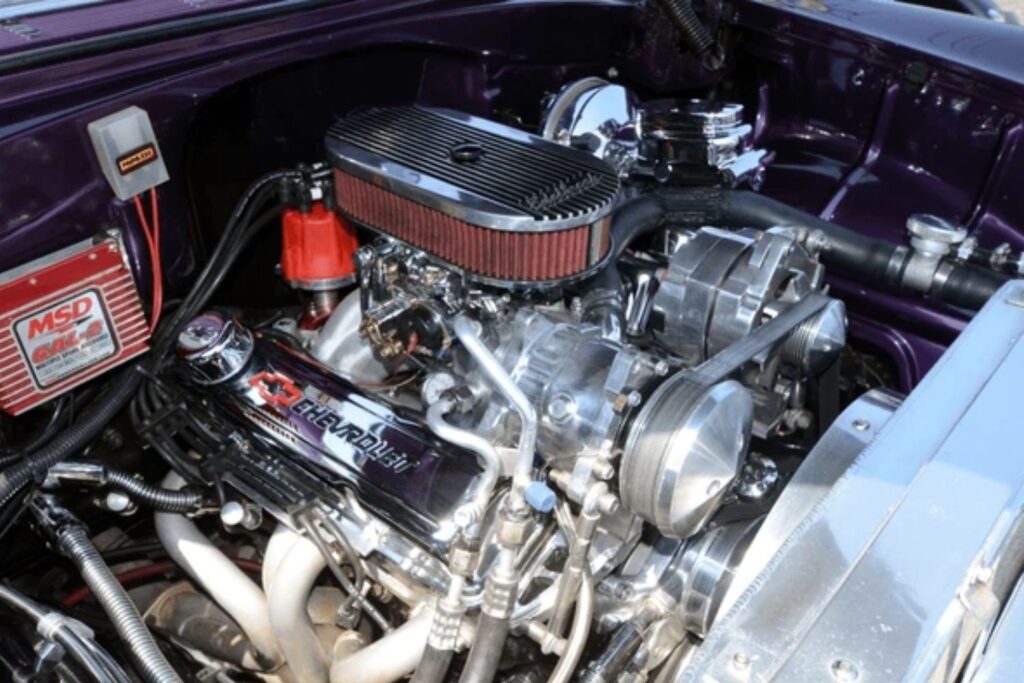
Introduction
Few engines have earned the kind of legendary status that the Chevy 350 enjoys. Introduced in 1967, this 5.7L small-block V8 quickly became a cornerstone of General Motors’ performance and utility lineup. From muscle cars like the Camaro and Corvette to workhorses like full-size Chevy pickups, the 350 proved to be versatile, reliable, and endlessly modifiable.
Its reputation was built on a simple formula: a compact design, accessible torque, and broad compatibility across platforms. Over the years, the Chevy 350 has powered everything from factory hot rods to street sleepers, marine engines, and even custom kit cars. Even decades after its debut, it remains one of the most popular crate engines in the world.
In this article, we’ll explore what makes the Chevy 350 so enduring—from its technical specs and tuning potential to real-world applications and help builders and engineers push this iconic engine even further through PatSnap Eureka AI Agent.
Key Features of the Chevy 350
What makes the Chevy 350 a standout small-block V8? From engine architecture to fuel delivery, Eureka Technical Q&A explores how this legendary powerplant strikes a dependable balance of displacement, efficiency, and engineering simplicity.

Displacement and Configuration
- Displacement: The Chevy 350 has a displacement of 350 cubic inches (5.7 liters). This is the total volume of all the engine’s cylinders, which determines the engine’s size and potential power output.
- Cylinder Configuration: It is a V8 engine, meaning it has eight cylinders arranged in a “V” shape. This configuration provides a balance of power, smoothness, and compactness.
Bore and Stroke
- Bore: The bore (diameter of the cylinders) is 4.00 inches (101.6 mm).
- Stroke: The stroke (distance the piston travels up and down) is 3.48 inches (88.4 mm). The stroke is shorter than the bore, classifying it as a “short-stroke” engine, which typically favors higher RPM performance.
Valve Train
- Valve Configuration: The Chevy 350 uses an overhead valve (OHV) design, also known as a pushrod engine. It has two valves per cylinder (one intake and one exhaust), totaling 16 valves.
- Camshaft: The camshaft is located in the block, and it uses pushrods to operate the rocker arms, which in turn open and close the valves. The camshaft’s design (lift and duration) significantly impacts the engine’s performance characteristics.
Fuel Delivery
- The Chevy 350 was produced with various fuel delivery systems over the years. Early models used carburetors, while later versions employed fuel injection. The transition to fuel injection began in the 1980s, with the 350 small-block becoming fuel-injected for the 1985 Corvette, while lesser GM cars kept their trusty four-barrel carburetors. Throttle body fuel injection only became standard in the late ’80s. Many crate engine versions, like the SP350/357 and SP350/385, require premium fuel.
Ignition System
- The Chevy 350 uses a traditional distributor-based ignition system in most of its configurations. The distributor sends the spark to the correct cylinder at the right time. Some later models and crate engine versions may use electronic ignition systems.
Cooling System
- The Chevy 350 is a water-cooled engine, meaning it uses a liquid coolant (typically a water and antifreeze mixture) to regulate temperature and prevent overheating. It has a radiator, water pump, thermostat, and cooling passages within the engine block and cylinder heads.
Lubrication System
- The engine uses a pressurized lubrication system to deliver oil to all moving parts, reducing friction and wear. It includes an oil pump, oil pan, oil filter, and oil passages throughout the engine.

Performance & Tuning Potential
- Horsepower and Torque: The Chevy 350’s horsepower and torque ratings vary depending on the specific build and year. For example, the HT383 crate engine offers 323 horsepower at 4,200 rpm and 444 pound-foot (602 Nm) at 3,000 revolutions per minute. The 350 HO Turn Key levels up to 333 hp at 5,100 rpm, yet torque drops to 381 lb-ft (517 Nm) at 3,700 rpm. The street-performance engine, the SP350/357 Base, delivers 357 hp at 5,500 rpm and 407 lb-ft (552 Nm) at 4,000 rpm on premium fuel. The SP350/385 incorporates beehive-type valve springs and high-flow aluminum cylinder heads for low-rpm torque and high-rpm performance, good for 385 hp at 5,600 rpm and 405 lb-ft (549 Nm) at 3,600 rpm.
- Tuning Potential: One of the Chevy 350’s defining characteristics is its exceptional tuning potential. Its design allows for numerous modifications to increase power, such as upgrading the camshaft, intake manifold, carburetor/fuel injection system, headers, and exhaust system. Each has its characteristics, for example, dual-plane intake manifolds typically found in street-driven vehicles offer improved low-end torque. The Chevy 350 is part of the Chevrolet small-block V8 family, which first saw the light of day in 1954, with the 350 arriving in the late 1960s as an option for the Camaro SS. It was and still is highly tunable, achieving some pretty impressive power figures.
Comparison with Other Small‑Block V8s
Displacement and Bore/Stroke
Chevy 350: 5.7 liters (350 ci), with a 4.00-inch bore and 3.48-inch stroke.
Other Small-Blocks: Displacements range from 262ci (4.3L) to 400ci (6.6L). For example, the 265ci “Mighty Mouse” made 195 hp, the 283ci had a 3.00-inch stroke, the 327ci used a 3.25-inch stroke, and the 400ci matched the 350’s bore but had a longer 3.75-inch stroke.
Power and Torque
Chevy 350: Typical stock output ranged from 150–200 hp and 250–300 lb-ft. Performance versions like the L82 made up to 220 hp, while the 350 HO Turn Key delivers 333 hp and 381 lb-ft.
Other Small-Blocks: Outputs vary by configuration. The HT383 offers 323 hp and 444 lb-ft; SP350/357 delivers 357 hp and 407 lb-ft; SP350/385 produces 385 hp and 405 lb-ft. Entry-level options like the 350/265 Base offer 265 hp and 351 lb-ft.
Valvetrain
Chevy 350: Most used a hydraulic flat-tappet camshaft with 1.5:1 or 1.6:1 rocker arms.
Other Small-Blocks: Performance variants used solid-lifter or roller cams. The HT383 has a hydraulic roller cam, while the SP350/385 features beehive springs and high-flow aluminum heads.]

Compression Ratio
Chevy 350: Compression ranged from 8.0:1 to 9.5:1 depending on year and model.
Other Small-Blocks: Ratios vary—HT383 runs at 9.1:1, and the 350/265 Base uses 8.0:1.
Fuel Delivery
Chevy 350: Most used carburetors, often the Rochester Quadrajet.
Other Small-Blocks: Later models featured fuel injection. For instance, the 283ci with optional Ramjet injection produced 259 hp. SP350/357 engines require premium fuel.
Cylinder Heads
Chevy 350: Various head designs were used over the years; L82 heads are notable for improved airflow.
Other Small-Blocks: Options range widely. Vortec iron heads (used in the HT383E) and modern aluminum heads offer better performance and efficiency.
Crankshaft and Rods
Chevy 350: Equipped with cast or forged crankshafts and either powdered-metal or forged steel rods.
Other Small-Blocks: The HT383 features a forged crank for durability. The 350 HO uses nodular iron with cast pistons and powdered-metal rods. New GM 350s feature forged cranks and upgraded internals.
Block
Chevy 350: Traditional small-block architecture with 4-bolt mains on high-performance versions.
Other Small-Blocks: New GM crate engines come with all-new 4-bolt main blocks, roller-cam ready and fuel pump compatible. The 350/265 Base is a cost-effective, all-new alternative to rebuilding Gen 0 small-blocks.
Reliability of the Chevy 350
Why has the Chevy 350 earned its reputation as one of the most iconic small-block V8s in automotive history? PatSnap Eureka reveals factors that solidify its legacy:

- Simplicity of Design: The Chevy 350’s design is relatively simple, which makes it easier to maintain and repair. The engine’s components are readily available, and many mechanics are familiar with its design.
- Durability: The Chevy 350 is built to last. Its cast-iron block and cylinder heads provide excellent durability and heat dissipation. The engine can withstand high temperatures and pressures, making it suitable for a variety of applications. The HT383 crate engine, for example, features a cast-iron block with four-bolt main caps, a forged steel crankshaft, hypereutectic aluminum pistons, and a hydraulic roller camshaft.
- Versatility: It can be used in a wide range of vehicles, from cars to trucks to boats, and can be adapted to various performance levels. The engine is designed for pre-1980 models.
- Aftermarket Support: There are countless performance parts and accessories available, allowing owners to customize and upgrade their engines. Holley Performance Products, for example, has sold more speed parts for small-block Chevys than all other engines combined.
- Proven Track Record: It has been used in millions of vehicles over the years, and its design has stood the test of time. The engine has been used in race cars, off-road trucks, boats, and even custom motorcycles.
- Warranty: The new Chevy Small Block V8 is intended for competition use only, and includes a 24-month / 50,000-mile limited warranty. GM Genuine Parts engines feature a solid 3-year/100,000-mile limited warranty, whichever comes first.
- Reputation: The Chevy Small Block 350 is still one of the most respected and dependable on the market. Chevy poured their best workers into it, designing an engine that’s not only powerful and robust but also easy to handle, nice to tune up and exceptionally reliable. A well-maintained 350 can last longer than the car it’s in and has limited need for upkeep.
Applications of the Chevy 350
| Application Area | Examples | Key Advantages |
|---|---|---|
| Passenger Vehicles | Camaro, Corvette, Impala, Monte Carlo, Chevelle, Malibu | Smooth torque, reliable performance for daily driving |
| Trucks & SUVs | Chevy C/K Series, Blazer, Suburban, GMC Sierra, Jimmy | Strong low-end torque, ideal for towing and hauling |
| Marine Engines | Used in MerCruiser and Volvo Penta inboard/outboard systems | Durable, easy to service in marine environments |
| RVs & Camper Vans | Common in 1970s–1990s Class A and Class C motorhomes | Balanced power-to-weight for highway cruising |
| Performance Builds | Widely used in hot rods, restomods, drag cars, track cars | Massive aftermarket support and upgrade potential |
| Industrial & Farm Use | Generators, irrigation pumps, agricultural equipment | Simple design, dependable for stationary power needs |
FAQs
The horsepower of a Chevy 350 varies depending on the specific model and year, typically ranging from about 150 to 370 horsepower in stock form, with performance versions exceeding that.
Yes, the Chevy 350 engine is a 5.7-liter displacement small-block V8. The terms “350” (cubic inches) and “5.7 liters” refer to the same engine size.
Yes, the Chevy 350 V8 is widely regarded as a reliable, versatile, and easy-to-maintain engine with a strong aftermarket support. It has powered countless cars and trucks over decades.
1967‑69 Camaro SS, 1968‑79 Nova, virtually every 1969 Chevy passenger car, plus 1996‑2002 GMT‑400 trucks and many more.
To get detailed scientific explanations of the Chevy 350, try Patsnap Eureka.

